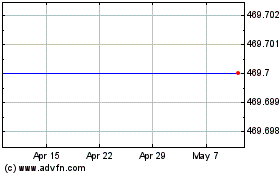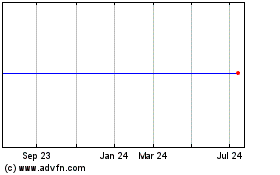Oil Prices Drop to Fresh Six-Year Lows
August 19 2015 - 12:00PM
Dow Jones News
By Timothy Puko
Oil prices fell to a fresh six-year low Wednesday after data
showed a surprise increase in U.S. stockpiles, adding to a massive
glut of crude around the globe.
Light, sweet crude for September delivery dropped $1.27, or 3%,
to $41.35 a barrel on the New York Mercantile Exchange.
The September contract expires Thursday and the more actively
traded October contract was down $1.27, or 3%, at $41.85 a barrel.
U.S. oil fell as low as $41.18 a barrel, the lowest intraday price
since March 4, 2009.
Brent, the global benchmark, fell 94 cents, or 1.9%, to $47.87 a
barrel on ICE Futures Europe.
More than half of the losses for the day came in just 15 minutes
after the U.S. Energy Information Administration released its
official data on oil stockpiles. It showed crude stocks rose by 2.6
million barrels last week compared with analysts' expectations for
a 1.1 million-barrel fall.
That "got everybody by surprise," said Scott Shelton, broker at
ICAP PLC. "I don't see anything good in this report."
The oil-and-gas boom from U.S. shale production has helped flood
the market and sink oil prices by about 60% from their 2014 highs.
Daily production did fall during the week ended Aug. 14, but by
only 0.5%, according to EIA.
At 9.3 million barrels a day, U.S. output is on track to be the
highest since 1972. Global exporters have also ramped up production
to compete with U.S. shale, a trend continuing in full force.
Imports grew by 6.1% for the week to 7.6 million barrels a day, EIA
said. That gives credence to recent reports showing Saudi Arabia
has increased its exports by 430,000 barrels a day, Mr. Shelton
said.
Oversupply is estimated to be between 500,000 and three million
barrels a day world-wide, and many market observers now expect that
to linger for longer than what was once commonly anticipated.
The latest data has only confirmed that fear and exacerbated a
selloff that has put oil in a bear market for the summer, said Dean
Hazelcorn, trader at the brokerage Coquest Inc. in Dallas.
"The market's been given zero reason to buy," he added.
Domestic crude inventories rose to 456.2 million barrels last
week, up from 453.6 million barrels last week, the EIA said. The
EIA's weekly production figures are based on a statistical model,
not reported production.
"While a renewed decline in drilling activity might provide some
support for prices, at best they are only likely to grind a little
higher over the next few years," analysts at Capital Economics said
in a note to clients.
Gasoline stockpiles fell by 2.7 million barrels. Analysts had
expected gasoline supplies to fall by 1.4 million barrels. Gasoline
futures extended losses to 3.4% to $1.5906 a gallon.
Diesel supplies rose by 594,000 barrels, less than the
1.2-million-barrel increase that analysts had expected. Diesel
futures extended losses to 1.7% to $1.5328 a gallon.
Georgi Kantchev contributed to this article.
Write to Timothy Puko at tim.puko@wsj.com
Subscribe to WSJ: http://online.wsj.com?mod=djnwires
(END) Dow Jones Newswires
August 19, 2015 11:45 ET (15:45 GMT)
Copyright (c) 2015 Dow Jones & Company, Inc.
ICAP (LSE:IAP)
Historical Stock Chart
From Mar 2024 to Apr 2024

ICAP (LSE:IAP)
Historical Stock Chart
From Apr 2023 to Apr 2024
